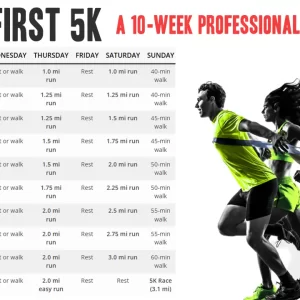Contents
- What is Considered Long-Distance Running?
- Benefits of Long-Distance Running
- Common Beginner Mistakes to Avoid
- Building Your Aerobic Base: The Run-Walk Method
- Weekly Progression Plan for New Runners
- Recovery Tips and Nutrition Basics
- Choosing the Right Shoes and Gear
- FAQ: Can You Lose Weight with Long-Distance Running?
What is Considered Long-Distance Running?
Long-distance running refers to continuous running over extended distances—typically anything longer than 5 kilometers (3.1 miles). For most recreational runners, distances such as the 10K (6.2 miles), half marathon (13.1 miles), and full marathon (26.2 miles) are considered standard benchmarks in long-distance running.
From a physiological standpoint, running for 30 minutes or more requires significant contributions from the aerobic energy system. That means long-distance running emphasizes endurance, efficient oxygen utilization, and mental stamina.
Benefits of Long-Distance Running
1. Cardiovascular Health
Long-distance running improves heart efficiency, lowers resting heart rate, and enhances stroke volume. Regular endurance training increases VO₂ max—the body’s ability to utilize oxygen—leading to better overall fitness and reduced risk of cardiovascular disease.
Reference: American College of Sports Medicine (2021)
2. Mental Health & Cognitive Function
Endurance running has been linked with reduced symptoms of anxiety and depression. The meditative rhythm of steady-state running promotes mood-regulating neurotransmitters like serotonin and endorphins.
Reference: Frontiers in Psychology, 2020
3. Metabolic Efficiency
Long runs improve mitochondrial density and fat oxidation. Over time, your body becomes more efficient at using fat as fuel, which supports endurance and weight regulation.
Reference: Sports Medicine, 2018
Common Beginner Mistakes to Avoid
- Doing too much too soon: Rapid mileage increases can lead to overuse injuries like shin splints, plantar fasciitis, or stress fractures.
- Ignoring recovery: Skipping rest days or neglecting sleep undermines progress and increases injury risk.
- Poor footwear: Worn-out or inappropriate shoes can lead to biomechanical issues and pain.
- Inconsistent pacing: Running too fast too often prevents aerobic adaptation and leads to early burnout.
- Neglecting strength training: Weak hips, core, and glutes contribute to inefficient form and injury risk.
Building Your Aerobic Base: The Run-Walk Method
The run-walk method, popularized by coach Jeff Galloway, is one of the safest and most effective ways for beginners to build endurance. Alternating running with walking helps improve aerobic capacity while reducing musculoskeletal stress.
Example for beginners:
- Week 1: Run 1 minute, walk 2 minutes — repeat for 20–30 minutes
- Week 2: Run 2 minutes, walk 1 minute
- Week 3: Run 3 minutes, walk 1 minute
Gradually increase the running intervals while reducing the walking breaks.
Weekly Progression Plan for New Runners
A structured schedule allows your cardiovascular system, muscles, and joints to adapt safely. Here’s a simple 4-week progression:
| Week | Sessions/Week | Total Weekly Time | Long Run |
|---|---|---|---|
| 1 | 3 | 60 minutes | 20 minutes |
| 2 | 3–4 | 75 minutes | 25 minutes |
| 3 | 4 | 90 minutes | 30 minutes |
| 4 | 4 | 100 minutes | 35 minutes |
After 4 weeks, increase your weekly volume by no more than 10% to minimize injury risk.
Recovery Tips and Nutrition Basics
Recovery:
- Sleep 7–9 hours per night
- Take at least one full rest day per week
- Foam rolling and light stretching can reduce soreness
Nutrition:
- Prioritize complex carbohydrates for fuel (oats, rice, potatoes)
- Include lean protein (chicken, beans, tofu) for muscle repair
- Stay hydrated and replenish electrolytes, especially after long runs
Post-run snack: Aim to consume a 3:1 ratio of carbs to protein within 30–60 minutes post-run for optimal recovery.
Choosing the Right Shoes and Gear
Running Shoes:
- Get fitted at a specialty running store
- Replace shoes every 300–500 miles
- Choose a model based on gait and arch support
Apparel:
- Moisture-wicking clothes reduce chafing
- Use anti-chafe balm in problem areas
- Dress in light layers for weather flexibility
Accessories:
- A GPS watch or app for tracking progress
- Reflective gear for low-light runs
- A hydration belt for longer efforts
FAQ: Can You Lose Weight with Long-Distance Running?
Yes, long-distance running can contribute to fat loss when paired with a slight calorie deficit. However, excessive mileage without proper fueling may increase hunger hormones (like ghrelin) and lead to overeating.
Tips for weight loss while running:
- Focus on nutrient-dense, satiating foods
- Avoid “reward eating” after every run
- Add strength training to preserve lean muscle
References
- American College of Sports Medicine. (2021). ACSM’s Guidelines for Exercise Testing and Prescription, 11th ed.
- Galloway, J. (2016). Galloway’s Book on Running. Shelter Publications.
- Jones, T. W., et al. (2018). “Endurance adaptations and metabolic changes in long-distance runners.” Sports Medicine, 48(6), 1303–1323.
- Rebar, A. L., et al. (2020). “Effect of running on mental health outcomes: A systematic review.” Frontiers in Psychology, 11:586532.
- Nieman, D. C. (2020). Exercise Testing and Prescription: A Health-Related Approach, 9th ed.



